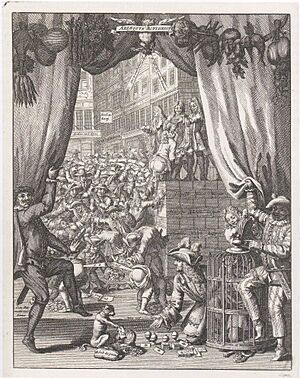Pieter Langendijk facts for kids
Pieter Langendijk (born in Haarlem on July 25, 1683 – died in Haarlem on July 9 or 18, 1756) was a very talented Dutch artist and writer. He worked as a damask weaver, a city artist, a playwright (someone who writes plays), and a poet.
Pieter Langendijk's Life Story
Pieter's father, Arend Kort, was a mason from Langedijk. His father passed away in 1689. For a while, Pieter was looked after by William Sewell, a poet from Amsterdam. In 1695, Pieter and his mother moved to The Hague. His mother started a business selling linen. Pieter became a weaver and learned to design patterns. He also joined groups of artists and began writing poetry.
Around 1708, Pieter took classes to learn drawing and painting. On his 28th birthday, his play Don Quichot op de Bruiloft van Kamacho (Don Quixote at the Wedding of Camacho) was first performed. It was a big hit! The play ran for a long time at the Schouwberg of Van Campen theater. The next year, he released two more funny plays: De zwetser (The Boaster) and The Mutual Marriage Deception.
Pieter wrote many comedies, similar to the style of the famous French playwright Molière. He even translated some of Molière's works. With Hermanus Angelkot, he wrote a play called Cato. Another very famous play was Quincampoix, or the gamblers on the Stock Exchange. He wrote this in 1720, a year when many people lost money in Paris because of risky investments. His play Arlequin Actionist was a short, funny play about stock market gambling. It even included a real fight, dancing, and music!
In 1721, Pieter became a leader (called "Factor") of the Haarlem Society Trou Moet Blycken. He moved back to Haarlem with his mother in 1722. That same year, he was chosen as the city artist for Haarlem. From 1724 to 1744, he wrote poems for the city every year. After his mother died in 1727, he got married. His wife passed away eleven years later. In 1747, Pieter had to sell many of his books and belongings. He later lived in Haarlem's Proveniershuis, a special house where he got free lodging. In return, he was supposed to write a history of the city. The last history of Haarlem was from 1628, written by Samuel Ampzing. Pieter passed away in 1756.
Pieter Langendijk's Plays and Poems
Pieter wrote five main plays that were all about the same length. They had a clear structure, with a beginning, a problem, and a solution. He followed the classic rules for plays, making sure the story happened in one place, at one time, and focused on one main action. He used this classic style to show his audience how people in society acted. His plays were comedies that showed the funny side of human behavior, especially among the wealthier or struggling middle classes. He didn't preach to his audience but simply showed them what was happening. Pieter wrote only one tragedy, which was later in his life.
Popular Plays by Langendijk
Het wederzijds huwelijksbedrog (The Mutual Marriage Deception)
This play is a comedy about two people, Lodewijk and Charlotte. Lodewijk is from a noble family but has money problems. He pretends to be a rich Polish count. Charlotte also comes from a noble family that has lost its wealth. She pretends to be much richer than she is. It's very funny to watch them both try to convince the other that they are very wealthy!
Their "mutual marriage deception" is revealed at the theater by Karel, Charlotte's brother. Even though they lied, Charlotte and Lodewijk still get married because they truly fell in love. There's also a side story with Charlotte's maid, Klaartje, and Lodewijk's friend, Jan. Jan lies to Klaartje, and she breaks up with him. In the end, Jan, who was a traitor in the army, runs away to avoid punishment from Karel.
De spiegel der vaderlandse kooplieden (The Mirror of Dutch Merchants)
This play also shows the audience a reflection of themselves. It compares two generations of merchants: those from the 1600s and those from the 1700s. Ernst and Hendrik are hardworking merchants from the 1600s. They become successful through their efforts. Their sons, Lichthart and Losbol, represent the next generation. They waste all the money their fathers earned, and the family fortune is lost. This play shows the consequences of being irresponsible with money.
Other Important Works
De Graaven van Holland, in jaardichten beschreven
This was a collection of Pieter's yearly poems for the city of Haarlem. The poems were about the Counts of Holland. His nephew, Hendrik Spilman, created engravings (pictures) for the book, which was published in 1745.
Pieter also wrote a history of Haarlem, but it was never published. However, his handwritten notes were used by Gerrit Willem van Oosten de Bruyn in 1765 for his own work on the city's history.
Works
- Spiegel der Vaderlandsche Kooplieden door Pieter Langendijk. Waar agter gevoegd is het Leeven van den Dichter. Uitgegeven met inleiding en aantekeningen door dr. G.A. van Es, (1979)



